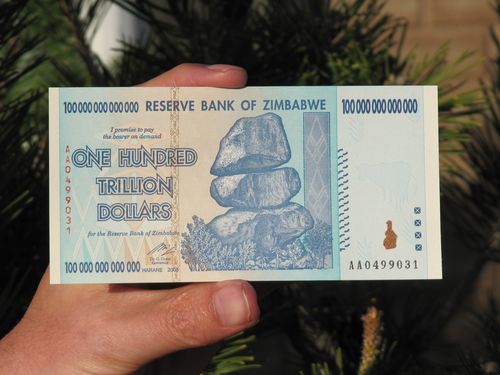My father was an undergraduate student in erstwhile USSR, on a Soviet Government Engineering Scholarship in September of 1990. The scholarship also accounted for a monthly amount of 90 roubles for day to day expenses and after the deduction of 2 roubles or so for infrastructure costs, he got to keep 88 roubles. This was more than ample for his sustenance and within a span of three months, he had saved enough to come back home for Christmas, to India. Now, would you believe me if I told you that in August 1991, with the Soviet Union on the verge of collapse, this very same scholarship of 90 roubles wasn't enough for him to buy a day's breakfast? He once described the situation in Russia to me as: "Initially people would go to the shops with money in their pockets and come back with bags of grain; now they go with bags of money to try and fill their pockets with a handful of grain." What the USSR or Russia was experiencing at that time was a case of extreme inflation bordering hyperinflation, with the annual inflation rate reaching a peak of 5000%.

Hyperinflation is the rapid increase in the prices of commodities due to a rapid fall in the value or 'purchasing power' of money. The inflation rate refers to the percentage increase in the general price level of the market. When this rate exceeds a 50% monthly rate of increase, it is known as hyperinflation. Let me try and elucidate this concept with an example. For an economy experiencing minimum levels of hyperinflation at a stable monthly inflation rate of 50%, an apple which costs 10 rupees on the 1 st of January this year, will cost about 1300 rupees on the 1 st of January next year and 1.7 lakhs the year after.
What Russia underwent after the disintegration of the Soviet Union was a relatively smaller instance of hyperinflation which was eventually controlled using economic policy and government regulation. The lack of these effective policies and regulations is what caused hyperinflation to spin out of control, for Post WWII Hungary and Zimbabwe in 2008, the two worst cases of hyperinflation ever recorded. The hyperinflation rates in Hungary peaked at 1.3 × 10^16 % per month, which meant that the prices of commodities doubled every 15.6 hours. In more recent times, the inflation rates in Zimbabwe peaked at a daily increase of 98% which meant that the prices doubled every 24.7 hours. The yearly rate of inflation simply sounds absurd, coming in at 7 × 10^ 108 %. To cope with this, the Reserve Bank of Zimbabwe issued the 100-trillion dollar note shown here, worth a mere 40 US cents.
In times like this, every item in the market has a price tag in the millions and billions. Money loses all its value and is worth less than the paper it is printed on. Because of this, countless people lose their life's savings. Employees and workers stop going to work because their entire annual salary can't cover their bus ride home. A comment made by a nurse named Maigualida Oronoz helps you understand what living with hyperinflation is like. In an interview with The Guardian, she says, "We are millionaires, but we are poor. We can just about eat, but if some health emergency happens, we'll die because the prices of medicine are sky-high and rise every day."